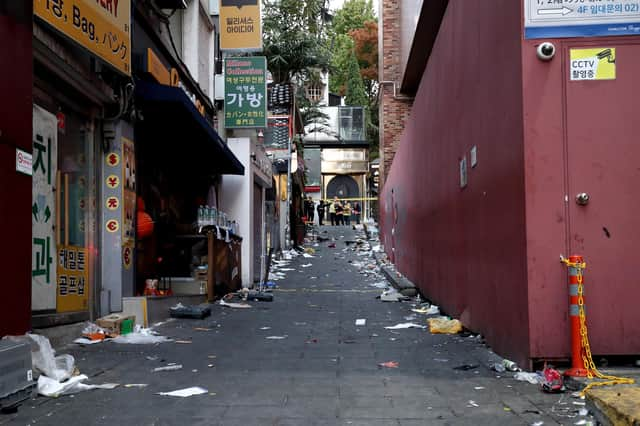Deadly Seoul crowd crush tragedy was preventable but will be repeated the world over until authorities take action – Professor Joe Goldblatt


The joy of reuniting with friends following the desperate days of the Covid pandemic may have increased this enthusiasm to the point at which judgement was suspended. Then, quickly, the euphoria was replaced by terror as people found themselves in a tragic death trap because of poor planning by civic officials.
The recent crowd crush tragedy in Seoul, which saw more than 150 people, mostly teenagers, lose their lives due to suffocation as they descended down a steep hill on a narrow street, was preventable. In fact, I believe that all crowd-crush incidents are preventable.
Advertisement
Hide AdAdvertisement
Hide AdHowever, one thing is for certain: it will happen again, unless civic leaders resolve to try and prevent these catastrophes.
India, one of the world’s most populated countries, has had the most documented notable human stampedes and crushes with 28 individual incidents. The deadliest human crush of all time, with an estimated 10,000 deaths, occurred during the First Jewish-Roman War in AD66 and the most documented deaths, with 5,000, occurred at the Ponte das Barcas in Portugal in 1809. Since the early 19th century, more than 200 crowd stampedes have been recorded, resulting in thousands of deaths of mostly young people.
In the early part of this millennium, the governor of the US State of Rhode Island appointed me to chair a committee investigating the impacts of the 2003 Station nightclub fire in West Warwick. In this deadly event, more than 100 young adults died as they tried to escape a burning inferno that had been caused by the misuse of indoor pyrotechnics. The majority of the victims died from being trampled at the front door as they tried to escape by the same door where they had entered.
Recently, I conducted a tour in Edinburgh that was well publicised on social media. One post received 17,800 views. A few days before the tour, I wondered what might happen if all the people who viewed that post actually turned up without confirming their participation in advance. The propensity of promotion opportunities through social media should remind all event producers and civic leaders of the need to be cautious about over-promotion that could lead to a repeat of the Halloween nightmare recently experienced in the South Korean capital.
How do we prevent these tragedies? Over the past 100 years, very sophisticated models have been developed for crowd assessment, analysis, planning, and control. Organisations such as the International Festivals and Events Association and others have led through their effective and well-attended crowd management education programmes. However, unless our civic leaders, who are ultimately responsible for applying this education and executing the plans they develop, take radical action to prevent future incidents, they shall continue to recur.
Whilst there is no guarantee that people will not be harmed at future events, I believe the following three tactics must be deployed immediately and universally to attempt to prevent or mitigate future tragedies.
Firstly, we must reduce the size of crowds to a level that is manageable by local authorities. Therefore, those agencies responsible for issuing assembly permits must revise their maximum number of participants to a number that can be managed effectively by stewards and police. For example, if a public street cannot be dispersed and cleared by police on horseback in a few minutes’ time, the event should not be given permission to be held.
Secondly, we must provide well-signed and easily accessible escape routes for crowds to ensure that in the case of over-crowding there is always a safe and secure way to find the egress. These escape routes need to be clearly marked both above eye level and at ground level with clear signs in multiple languages so that even if individuals are forced to crawl they can still find the way to safety.
Advertisement
Hide AdAdvertisement
Hide AdThirdly, we must provide better education for participants, before and during the event, to help them understand the danger of being in a crowd, allowing them to make the decision of whether or not to participate upon arrival. A simple announcement, both written and verbal, reminding participants that large groups of people may be dangerous and they must decide whether or not to enter the crowded area, how to escape if necessary, and where to seek help is essential if we are to better protect everyone.
Throughout the world, people are now once again enthusiastically coming together to gather whilst celebrating their joys or marking sorrows, triumphs and other major milestones of human life. It is my view that it is the undisputed responsibility of civic leaders to ensure that every person who assembles in their jurisdiction has the best possible opportunity to participate and return home safely from these events.
Unless radical action is taken regarding human safety at future live events, the crowd crush episodes that we have experienced over the past century and beyond will most certainly be repeated. We can confidently assume, based upon past experience, that unless we are more vigilant, more young people will die from such horrors happening again and again.
Joe Goldblatt is emeritus professor of planned events at Queen Margaret University in Edinburgh, Scotland. He is the author, co-author and editor of over 40 books in the field of planned events. His views are his own. To learn more about his views visit www.joegoldblatt.scot
Comments
Want to join the conversation? Please or to comment on this article.